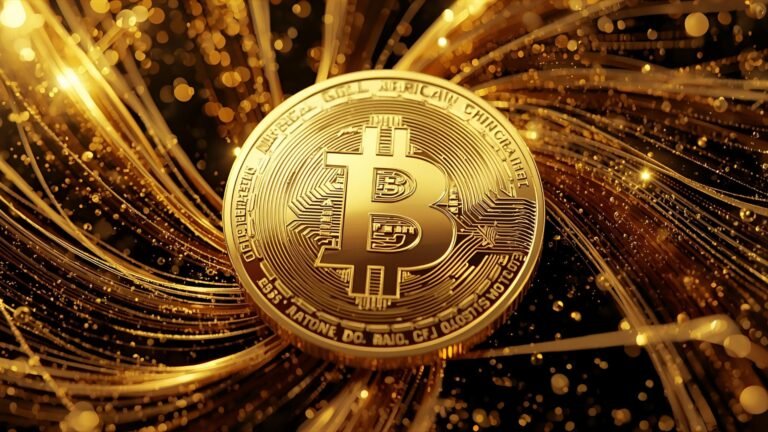The idea that Bitcoin is “digital gold” has evolved from a catchy metaphor into a dominant narrative guiding how millions perceive, value, and hold the world’s first cryptocurrency. For many crypto enthusiasts, Bitcoin’s Digital Gold Narrative explains not only price cycles and investor behavior but also the coin’s place within the broader financial system. The comparison to the yellow metal highlights scarcity, durability, and store-of-value properties. Yet it also underscores what sets Bitcoin apart: digital scarcity, decentralization, portability, and verifiability on a global, permissionless network.
In recent years, macroeconomic uncertainty, rising institutional interest, and the emergence of regulated on-ramps have all fueled this narrative. Supporters argue that Bitcoin functions as a hedge against inflation, a non-sovereign reserve asset, and a portfolio diversifier with asymmetric upside. Critics push back, citing volatility, regulatory risk, and environmental concerns. But whether one agrees or not, the data is clear: across social feeds, trading desks, podcasts, and research reports, Bitcoin’s Digital Gold Narrative among crypto enthusiasts. This article explores how that dominance took hold, why it persists, and what it means for the future of money.
The Digital Gold Thesis
At its core, the digital gold thesis argues that Bitcoin shares the economic properties that made gold a monetary standard for millennia. Gold’s scarcity arises from geology and the cost of extraction; Bitcoin’s scarcity is encoded in software, capped at 21 million coins. Where gold’s authenticity requires assays and custody chains, Bitcoin’s blockchain provides a public ledger that anyone can verify. And where transporting gold is expensive and slow, Bitcoin moves at the speed of the internet.
The term store of value lies at the heart of this thesis. A store of value preserves purchasing power across time. Gold achieved that reputation through hardness—resistance to supply inflation—and global recognition. Bitcoin seeks the same status through algorithmic issuance, proof-of-work security, and global liquidity. Proponents often emphasize digital scarcity as Bitcoin’s killer feature: no central bank can print more; no committee can vote to dilute holders. This fixed supply, combined with expanding demand, underpins the belief that Bitcoin can function as a modern, non-inflationary reserve asset.
The Role of Scarcity: Halvings and Supply Discipline

Scarcity in Bitcoin is not a marketing slogan; it’s enforced by protocol. Roughly every four years, the network undergoes a halving, reducing the block subsidy miners earn for validating transactions. This predictable schedule cuts the issuance rate, meaning fewer new BTC enter circulation over time. Gold miners can accelerate output when prices rise, but Bitcoin’s supply curve remains inelastic. Enthusiasts argue that halvings create a stock-to-flow dynamic reminiscent of monetary metals, tightening new supply and, historically, preceding bull cycles.
Beyond halvings, the network’s hash rate, difficulty adjustments, and robust miner competition preserve the integrity of this issuance schedule. When hash power fluctuates, the difficulty retargets to keep blocks arriving, on average, every ten minutes. The result is supply discipline indifferent to politics or profit motives—a rarity in today’s financial landscape. For believers in the digital gold thesis, this programmatic scarcity is the cornerstone of Bitcoin’s value proposition.
Demand Drivers: Adoption, Access, and Narrative Momentum
Supply is only half the equation; adoption fuels demand. Over the past decade, Bitcoin has moved from niche internet money to a recognized asset class. Brokerages, regulated exchanges, and, in some jurisdictions, exchange-traded products have lowered barriers for retail and institutions alike. Custody solutions, from hardware wallets to professional cold storage, support a spectrum of holders, from self-sovereign individuals to large funds with fiduciary obligations.
Narratives power markets. The story of Bitcoin as digital gold resonates because it’s easy to understand: scarce, global, and increasingly accessible. This narrative—in podcasts, analyst notes, and boardroom briefings—creates a feedback loop. As more investors buy into the thesis, liquidity deepens, volatility can moderate over long horizons, and institutional research grows more sophisticated. The narrative momentum reinforces itself, solidifying Bitcoin’s role as the flagship asset of the crypto market.
Macro Backdrop: Inflation, Rates, and Safe-Haven Appeal
The macro environment has also amplified Bitcoin’s allure. Periods of elevated inflation, monetary expansion, and geopolitical tensions push investors to search for assets outside traditional currency systems. Gold historically benefits during such times, and Bitcoin’s digital gold narrative positions it for similar flows. The fact that Bitcoin settles globally without intermediaries adds a layer of sovereignty that appeals to both individuals and institutions wary of capital controls, banking crises, or systemic shocks.
Critics note that Bitcoin can correlate with risk assets when liquidity is abundant, undermining the safe-haven claim. Proponents counter that over longer horizons, scarcity-driven assets decouple from cyclical equities, especially when monetary regimes shift. The truth may be nuanced: Bitcoin can behave like a high-beta macro asset in the short term, yet still function as a long-term store of value thanks to its supply profile and growing demand base. This dual identity—part tech growth, part hard money—keeps the narrative compelling.
Comparing Bitcoin and Gold: Similarities and Divergences
Bitcoin and gold share three key similarities: limited supply, global recognition, and value outside government decree. Both serve as hedges against monetary debasement and both have deep, international markets. But differences are just as important. Bitcoin is natively digital, making it trivially portable. Transferring value across borders takes minutes, not days, and costs a fraction of traditional methods. Bitcoin is also divisible to eight decimal places, enabling microtransactions inconceivable with physical bullion.
Verification differs as well. Gold requires trust in custodians, certificates, or assays; Bitcoin relies on cryptographic proofs and a transparent ledger. Finally, while gold’s long history grants it a trust premium, Bitcoin’s open-source innovation introduces features like multisig, lightning payments, and programmable smart contracts on adjacent layers. These divergences suggest that Bitcoin isn’t merely digital gold—it’s a new monetary substrate with properties unattainable in the physical world.
On-Chain Transparency and the Credibility of Monetary Policy
In traditional finance, investors infer monetary policy from central bank communications. In Bitcoin, the policy is code. Anyone can audit the supply schedule, track wallet flows, and examine on-chain metrics. This transparency lends credibility to the narrative that Bitcoin is a predictable monetary system. Tools that analyze UTXOs, realized capitalization, and HODL waves provide insight into investor behavior, time horizons, and market structure—analytics unavailable for gold or fiat money at the same granularity.
Transparency also disciplines the network. Any attempt to alter supply would require social consensus among users, miners, developers, and businesses. Because decentralization spreads power across stakeholders, unilateral changes face high resistance. This credible commitment to scarcity is why enthusiasts equate Bitcoin with a form of digital central bank that cannot inflate on a whim.
Institutional Participation and the Maturation of Market Structure
The rise of institutional participation has been pivotal. Hedge funds, asset managers, and corporations exploring treasury diversification have legitimized Bitcoin as a strategic allocation. Professional-grade prime brokerage, derivatives, and risk management tools foster a market structure comparable to traditional assets. The availability of ETF-like vehicles in certain jurisdictions introduces familiar wrappers for compliance-conscious investors, smoothing the path from curiosity to capital.
With institutional money comes a more sophisticated dialogue around portfolio construction. Analysts debate whether Bitcoin deserves a small, uncorrelated sleeve to protect purchasing power, or whether its asymmetric return profile argues for larger weightings. Regardless of the conclusion, simply being in the conversation cements Bitcoin’s status as digital gold in the minds of allocators evaluating inflation hedges, hard assets, and alternative investments.
Volatility, Risk, and Time Horizons
No discussion is complete without addressing volatility. Bitcoin’s price swings can be dramatic, especially compared to gold. For skeptics, this invalidates the store-of-value claim. For believers, volatility is the cost of early adoption in a scarce, global asset bootstrapping from zero. Historical patterns show that extended holding periods smooth drawdowns, while disciplined strategies—dollar-cost averaging, cold storage, and long-term conviction—align with the digital gold mindset.
Risk management also involves self-custody practices, hardware wallets, and multisignature security. The not your keys, not your coins mantra reflects a cultural norm: true scarcity matters only if holders control access. While custodians serve institutions and newcomers, the ethos of sovereign ownership remains central to Bitcoin’s identity and narrative.
Regulation: Friction, Clarity, and Legitimacy
Regulatory frameworks shape liquidity and access. In regions where governments pursue clear rules, regulated venues thrive, and mainstream adoption accelerates. Where rules are patchy or punitive, activity migrates offshore or into peer-to-peer rails. For the digital gold thesis, regulatory clarity does more than enable trading—it bestows legitimacy. When pensions, endowments, and corporate treasurers can hold Bitcoin within compliant structures, the asset steps closer to gold’s institutional status.
At the same time, overregulation could dampen innovation or push activity into opaque channels. The balance lies in safeguarding consumers and the financial system while preserving open access and permissionless innovation. Enthusiasts argue that Bitcoin’s censorship resistance and neutral settlement should be protected as public goods, akin to the open internet.
Energy, Mining, and the Sustainability Debate
Bitcoin’s proof-of-work consensus consumes energy, drawing scrutiny and debate. Critics view energy usage as wasteful; supporters contend that energy is the bedrock of digital hardness, securing a neutral monetary network. They highlight trends toward renewables, stranded energy, and demand response services that stabilize grids. Mining can monetize remote resources, turn waste gas into productive output, and encourage energy innovation by providing a buyer of last resort.
In the digital gold narrative, energy is not a bug but a feature—a real-world anchor that protects the network from cheap attacks. As mining migrates to cleaner sources and more efficient ASICs, the conversation increasingly centers on energy mix, geographic dispersion, and grid symbiosis. While the debate remains lively, the direction of travel suggests a maturing industry learning to live alongside environmental priorities.
Layer-2 Scaling and the Utility Beyond Holding
Critics sometimes argue that a pure store-of-value asset lacks utility. But Layer-2 solutions like the Lightning Network enable instant, low-fee payments, expanding Bitcoin’s use beyond passive holding. On Lightning, small transfers settle in seconds, challenging the idea that BTC is only a vault asset. Meanwhile, sidechains, wrapped Bitcoin in broader crypto ecosystems, and cross-chain bridges (with all their risks) explore new frontiers for programmability and financial inclusion.
Still, digital gold advocates caution against diluting the base layer’s security model. In their view, Bitcoin L1 should remain conservative—optimized for settlement finality, censorship resistance, and sound money. Innovation belongs in layers above, where experimentation can flourish without jeopardizing the core monetary anchor. This layered approach mirrors the gold standard era, where gold underpinned credit systems that carried higher throughput and user convenience.
Behavioral Finance: Why the Narrative Sticks
Narratives work because they distill complexity. Bitcoin’s digital gold narrative offers a simple mental model: a scarce, neutral asset for uncertain times. It engages both left-brain logic (fixed supply, transparent ledger) and right-brain symbolism (modern gold for the internet age). In communities where memetics, HODL culture, and long-term conviction are celebrated, the narrative becomes identity. People do not just own Bitcoin; they join a movement advocating financial sovereignty, open access, and self-custody.
This identity-building has economic consequences. Cohesive communities withstand drawdowns, creating a holder base less prone to panic. The more the story spreads, the more newcomers evaluate Bitcoin through the store-of-value lens, reinforcing demand during macro stress and underpinning cyclical recoveries. In effect, belief helps birth reality—so long as the fundamentals of scarcity and security continue to hold.
Also Read: Bitcoin Digital Gold Understanding Its Value Growth and Adoption
Data, Liquidity, and Network Effects

Liquidity begets liquidity. As order books deepen and markets expand across jurisdictions, spreads tighten, and price discovery improves. High-quality market data, from on-chain analytics to derivatives open interest, allows participants to size positions with greater confidence. This, in turn, attracts more sophisticated capital, from market makers to long-term allocators. Bitcoin benefits from network effects: more participants increase utility, which attracts still more participants.
Gold also enjoys network effects, but its settlement and verification layers are slower, costlier, and more opaque. Bitcoin’s programmable settlement and open data accelerate these effects in the digital realm. As long as the network remains open, neutral, and credibly scarce, its gravitational pull on capital—and on narratives—will likely continue.
Risks That Could Challenge the Narrative
For balance, it’s essential to note the risks that could challenge or reshape the digital gold story. Severe protocol bugs, cryptographic breakthroughs undermining security, or successful 51% attacks could erode trust. Sustained regulatory hostility in major economies could limit access, slow liquidity, or drive adoption into gray markets. A prolonged macro shift favoring high real yields could pressure risk assets, including Bitcoin, and test the thesis as an inflation hedge.
Technological competition also looms. Alternative assets or new digital commodities might capture mindshare if they deliver superior hardness or utility. Yet each of these risks faces high hurdles. Decentralized governance, open-source audits, and a global base of economically aligned participants make Bitcoin resilient. And the narrative’s strength—anchored in scarcity and sovereignty—continues to resonate even when markets wobble.
The Future: From Narrative to Norm
Where does the digital gold narrative go from here? If adoption continues, Bitcoin could transition from a story debated online to a norm in global portfolios. Allocations need not be large to move the needle; small percentages across institutions, family offices, and sovereign entities would deepen liquidity and stabilize markets. Meanwhile, steady improvements in wallet UX, custody, and compliance tooling will reduce friction for newcomers.
Education remains pivotal. As more investors understand private keys, multisig, and cold storage, the line between enthusiasts and mainstream participants blurs. Bitcoin’s role may evolve from speculative growth asset to baseline monetary commodity of the internet—used as collateral, a settlement asset, and a long-term savings vehicle. If that happens, the phrase digital gold will sound less like a metaphor and more like a description.
Why the Narrative Dominates Among Crypto Enthusiasts
No other crypto asset combines Bitcoin’s trifecta: immutability, predictable issuance, and network security proven over time. Many alternative coins prioritize speed, programmability, or experimental economics. Those features are valuable but different from the hard-money ethos. For investors seeking a non-sovereign store of value, Bitcoin occupies a unique niche. That singular focus clarifies the message and prevents brand dilution.
The culture around Bitcoin amplifies this focus. The community’s relentless emphasis on sound money, self-sovereignty, and long-term holding creates a cohesive identity that is easy to communicate. In contrast, broader crypto often fragments into competing use cases, each with its own jargon and risk profile. The simplicity of “digital gold” wins the narrative battle, especially in times of uncertainty, because it offers a clear, compelling answer to a timeless question: Where can I park value that won’t be diluted?
Conclusion
Bitcoin’s digital gold narrative dominates among crypto enthusiasts because it synthesizes technology, economics, and culture into a single, persuasive story. It speaks to the anxieties of an era—monetary expansion, geopolitical risk, institutional distrust—while offering a solution rooted in scarcity, transparency, and sovereign ownership. The comparison to gold is more than branding; it’s an analytical framework that helps investors understand why Bitcoin matters and how it fits within a modern portfolio.
As adoption broadens and infrastructure matures, Bitcoin’s role as a non-sovereign, globally verifiable store of value becomes harder to ignore. Risks remain, and debates will continue, but the trajectory is clear. In the internet age, where information and value flow together, a digital monetary primitive like Bitcoin can serve as both anchor and accelerant. That is why the narrative not only endures—it grows stronger.
FAQs
Why is Bitcoin called “digital gold”?
Bitcoin is dubbed digital gold because it mirrors gold’s scarcity and store-of-value properties while adding digital advantages like portability, divisibility, and verifiability. With a fixed 21 million cap and transparent issuance, Bitcoin aspires to preserve purchasing power over long time horizons much like gold, but with global, internet-native settlement.
Does Bitcoin actually hedge inflation?
Over short periods, Bitcoin’s price can be volatile and correlate with risk assets. Over longer horizons, supporters argue that programmed scarcity and growing adoption support its function as an inflation hedge. While not a perfect hedge for every cycle, its non-sovereign issuance and increasing recognition make it a compelling store-of-value candidate in diversified portfolios.
How do halvings impact the price and narrative?
Halvings cut the rate of new BTC issuance roughly every four years, reinforcing the scarcity thesis. Historically, market cycles have clustered around halvings as supply tightens and demand narratives intensify. While past performance doesn’t guarantee future results, halvings perpetuate the digital gold story by highlighting Bitcoin’s Digital Gold Narrative monetary policy.
Is gold still necessary if Bitcoin exists?
Gold and Bitcoin can coexist. Gold offers centuries of monetary history and broad central-bank ownership, while Bitcoin offers digital scarcity, portability, and transparent settlement. Some investors hold both as complementary hard assets, with Bitcoin delivering higher convexity and gold providing lower volatility.
What are the main risks to the digital gold thesis?
Key risks include regulatory crackdowns, protocol vulnerabilities, and prolonged macro regimes that favor cash over risk assets. Environmental concerns around mining energy also attract scrutiny. Nonetheless, decentralization, open-source governance, and migration toward cleaner energy have historically bolstered the network’s resilience and the staying power of the narrative.

